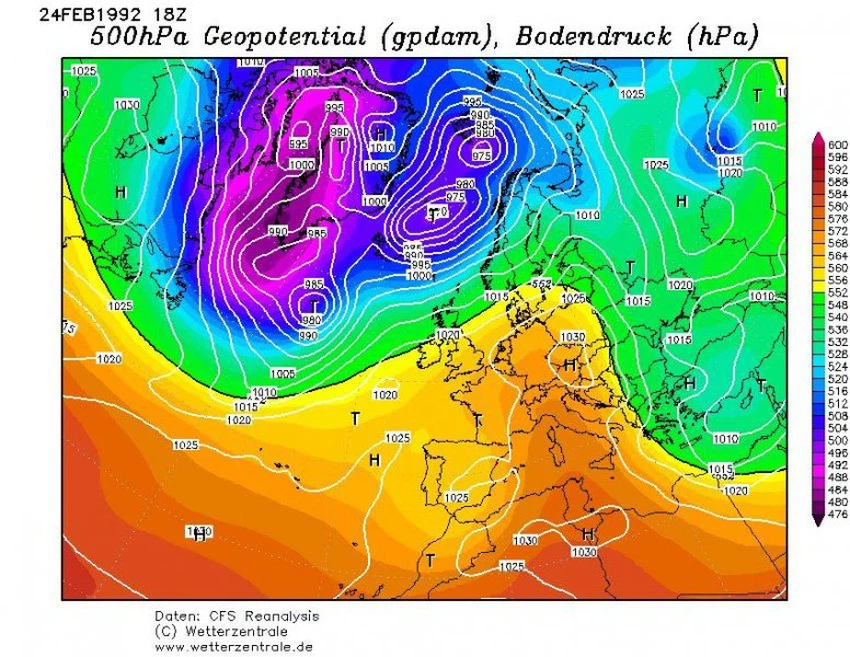The strongest snow storms dominate Jordan and the Levant at this time in 1992... What is their relationship to the violent eruption of the Pinatubo volcano?
Arab Weather - At this time 30 years ago, Jordan and the Levant were facing the strongest snow storms that passed through the region, after witnessing a harsh winter in which snow was repeated several times, so that the winter of 1991/1992 recorded a historical event with what was called the "7 snows" winter, So what happened that winter? What are the reasons that led the frequent snow to the region?
Snow storms in 1992..Does the Pinatubo volcano have anything to do with it?
The year 1991 witnessed the eruption of one of the most powerful volcanoes of the modern era. The volcano "Pinatubo" - located in the western part of the Philippines - suddenly woke up from its slumber, and violently erupted after months of repeated earthquakes, as the earth's crust was no longer able to contain the pressure of the rising magma, When the superheated magma rose and touched the groundwater underground, the water instantly turned into steam, causing the compressed gas underground to double the force of the explosion.
During its massive eruption on June 15, 1991, the Pinatubo volcano released about 20 million tons of sulfur dioxide (SO2) into the atmosphere and stratosphere, which is the second layer in the atmosphere and is characterized as a stable layer devoid of large vertical currents, so the aerosol particles remain The ash is light for a long time and its deposition is very slow.
There, the gas combines with water to form aerosol particles that reflect and scatter sunlight, preventing it from reaching the Earth's surface. This warms the stratosphere by 3.5 degrees Celsius, and cools the troposphere in the northern hemisphere by 0.2 to 0.7 degrees Celsius. These may seem like small numbers, but in an atmospheric system, small changes have big consequences.
These changes led to an increase in the temperature difference between the equator and the poles, which led to the enhancement of atmospheric dynamics on a global scale, the polar vortex at mid-latitudes, and a host of other atmospheric oscillation phenomena, which affected the Earth's climate, including the countries of the Middle East This was represented by unusually frequent polar depressions and snowfalls in the region during the winter of 1991/1992.

Winter (1991/1992) and more than 7 consecutive snows
Snow fell on Jordan and the Levant during the winter of 1991/1992 several times, starting during December 1991 and continuing during February, and the snow storm at the end of February was the most prominent, specifically on the date of February 24, 1992 AD, especially since it is the period in which it is seen People end of winter and approaching spring.
In that period, an air rise affected the central and western European continent, with a very cold and polar air mass over Siberia and the Black Sea regions, flowing towards the eastern basin of the Mediterranean and forming a snow storm, which affected the Kingdom for two days (24-26) of the month. February, Jordan and the Levant were at that time under heavy and rare snowfall.
In Jordan, snow was deposited in all regions of the Kingdom, even the southern regions, and temperatures dropped significantly until they approached 15 degrees below zero Celsius in the southern regions. The snow height in Sweileh and the northern areas of the capital Amman exceeded 120 cm, and the height of the accumulated snow exceeded in the Sharah Mountains and south Jordan 3 metres.
The events of those days are still stuck in the memory of Jordanians, as the water in the pipes froze until it blew up in many areas, which led to the water cut off from the homes. Livestock deaths occurred and great losses in agricultural and livestock wealth occurred, and many families faced a shortage of some basic foodstuffs, especially bread. The large accumulation of snow led to the closure of roads completely for several days.
Was Pinatubo volcano the only cause of the successive snowfalls in the winter of 1991/1992?
Specialists in the Arab Weather Center believe that the successive polar eruptions in that year on the Kingdom and the Levant cannot be considered irrefutable evidence that it was due to the volcano only, but that the atmospheric pattern that prevailed at that time was the result of the outcome of many factors that led to the secretion of that rare season. Whereas, with reference to the weather factors in that year, many positive factors converged with each other, perhaps the most prominent of which was the prevalence of the El Nino phenomenon in the tropical region of the Pacific Ocean. For example, at the time, southwestern and western Europe suffered from the consequences of weather patterns that year, in the form of strong air heights, which is the same reason that reflected positively on us in that season.
The Pinatubo volcano was not the first of its kind to affect weather patterns
In a larger and more comprehensive event, the Tambora volcano that erupted in Indonesia in 1816 was one of the most powerful eruptions in recorded history, releasing over 60 million tons of sulfur dioxide particles and aerosols that penetrated the upper layers of the atmosphere. The result was that the year 1816 was known as the year without summer, when a massive climate change occurred for a period of three years after the temperature of the planet decreased and weather disturbances, storms, snow, drought, diseases (cholera) and revolutions of the hungry in Europe (famines), agricultural crop failures and economic depression prevailed, and he died as a result of That's millions.
Arabia Weather App
Download the app to receive weather notifications and more..



